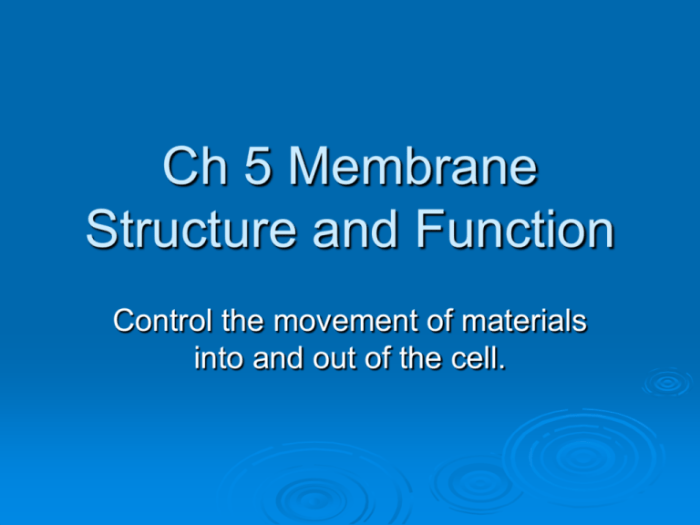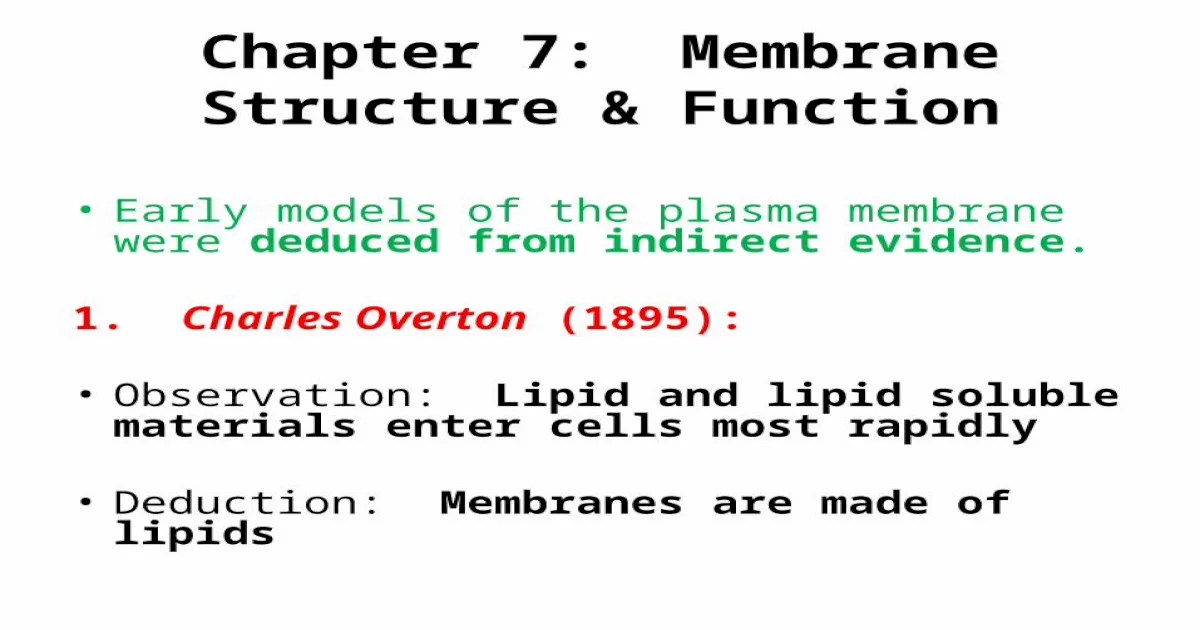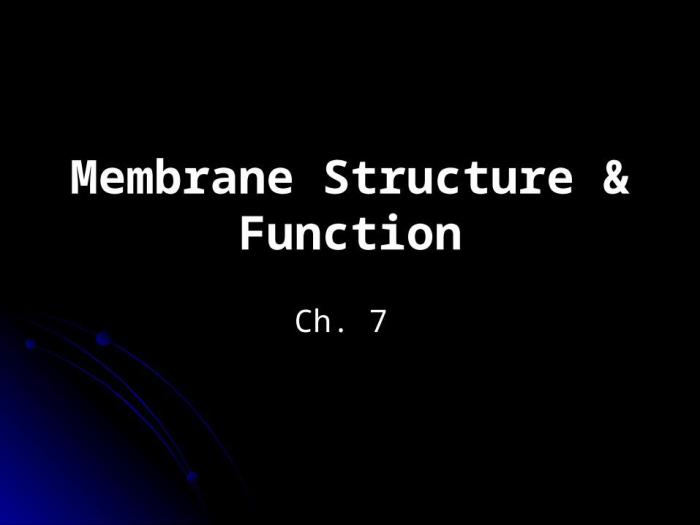Ch 7 membrane structure and function – Embark on a scientific odyssey with Chapter 7: Membrane Structure and Function, where we delve into the intricate world of cellular boundaries. This chapter unveils the fundamental principles governing the structure, function, and dynamics of cell membranes, providing a comprehensive understanding of their critical role in maintaining cellular homeostasis and orchestrating intercellular communication.
From the basic composition of the plasma membrane to the complex mechanisms of membrane transport, we will explore the fascinating interplay between membrane structure and function. Discover how membranes regulate the movement of molecules, facilitate cell signaling, and contribute to the overall health and function of cells.
Membrane Structure
The plasma membrane is the outermost layer of the cell and acts as a barrier between the cell and its surroundings. It regulates the movement of substances into and out of the cell and plays a crucial role in cell signaling and communication.
The basic structure of the plasma membrane is a phospholipid bilayer. Phospholipids are amphipathic molecules, meaning they have both hydrophilic (water-loving) and hydrophobic (water-hating) regions. The hydrophilic regions of the phospholipids face outward, interacting with the aqueous environment inside and outside the cell, while the hydrophobic regions face inward, forming the core of the membrane.
Roles of Membrane Components
- Phospholipids: Form the basic structure of the membrane and provide a hydrophobic barrier to the passage of water-soluble molecules.
- Cholesterol: Embedded in the phospholipid bilayer, cholesterol helps to maintain membrane fluidity and prevents it from becoming too rigid.
- Proteins: Embedded in or attached to the membrane, proteins perform various functions, including transport of molecules across the membrane, cell signaling, and cell adhesion.
Fluid Mosaic Model
The fluid mosaic model describes the plasma membrane as a dynamic, fluid structure. The phospholipids and cholesterol molecules are constantly moving laterally within the membrane, while the proteins are more restricted in their movement. This fluidity allows the membrane to adapt to changes in the cell’s environment and to carry out its various functions.
Membrane Function
The plasma membrane, the outermost layer of the cell, plays a vital role in maintaining cellular homeostasis and regulating interactions with the extracellular environment.
Regulation of Movement Across the Membrane
The plasma membrane selectively controls the movement of molecules into and out of the cell, creating a concentration gradient across the membrane. This regulation is essential for maintaining cellular integrity and function.
- Passive Transport:Molecules move across the membrane without the input of energy. Examples include diffusion (movement of molecules from high to low concentration) and osmosis (movement of water across a semipermeable membrane).
- Active Transport:Molecules move against their concentration gradient, requiring energy from ATP. This process allows cells to accumulate molecules essential for cellular processes.
Cell Signaling
The plasma membrane serves as a communication hub, transmitting signals between cells and the external environment.
- Receptors:Embedded in the plasma membrane, receptors bind to specific molecules (ligands) and trigger intracellular signaling cascades.
- Second Messengers:Ligand binding activates second messengers, such as cAMP or Ca2+, which amplify the signal and trigger specific cellular responses.
Membrane Transport

Membrane transport encompasses the movement of molecules and ions across the cell membrane, a selectively permeable barrier. It is crucial for maintaining cellular homeostasis, facilitating nutrient uptake, waste elimination, and signal transduction. Transport mechanisms can be classified into two main categories: passive and active transport.
Passive Transport
Passive transport mechanisms do not require energy input from the cell and rely on the concentration gradient or electrochemical gradient across the membrane. Examples include:
- Diffusion:Movement of molecules from an area of high concentration to low concentration. Small, nonpolar molecules like oxygen and carbon dioxide can directly diffuse through the lipid bilayer.
- Osmosis:Movement of water across a semipermeable membrane from an area of low solute concentration to high solute concentration, driven by the osmotic pressure gradient.
- Facilitated Diffusion:Transport of molecules assisted by membrane proteins called channels or carriers. Channels provide a hydrophilic pore, while carriers bind to the molecule and undergo conformational changes to facilitate transport.
Active Transport
Active transport mechanisms require energy input from ATP to move molecules against their concentration gradient or electrochemical gradient. Examples include:
- Primary Active Transport:Direct coupling of ATP hydrolysis to the transport process, e.g., the sodium-potassium pump (Na+/K+ ATPase) that maintains the electrochemical gradient across the membrane.
- Secondary Active Transport:Indirect coupling of ATP hydrolysis to the transport process. The primary active transport of one molecule creates a concentration gradient that drives the transport of another molecule, e.g., the sodium-glucose cotransporter (SGLT).
Role of Membrane Channels and Carriers
Membrane channels and carriers play essential roles in facilitating transport across the membrane:
- Channels:Integral membrane proteins that form hydrophilic pores, allowing specific ions or molecules to pass through without binding. They can be gated, regulated by ligands or voltage.
- Carriers:Integral membrane proteins that bind to the transported molecule and undergo conformational changes to move it across the membrane. They exhibit specificity and can be saturated at high substrate concentrations.
Membrane Asymmetry

Membrane asymmetry refers to the non-identical composition of the two leaflets of a biological membrane. This asymmetry is observed in both the lipid and protein composition of the membrane.
Lipid Composition
The inner and outer leaflets of the plasma membrane differ in their lipid composition. The outer leaflet is primarily composed of phosphatidylcholine (PC) and sphingomyelin (SM), while the inner leaflet is composed of phosphatidylethanolamine (PE) and phosphatidylserine (PS).
Protein Composition
The protein composition of the inner and outer leaflets of the plasma membrane also differs. The outer leaflet contains proteins involved in cell adhesion, cell signaling, and nutrient transport, while the inner leaflet contains proteins involved in signal transduction, cytoskeletal attachment, and membrane trafficking.
Functional Implications
Membrane asymmetry has several functional implications:
- Membrane fluidity:The different lipid compositions of the inner and outer leaflets contribute to the different fluidity of the two leaflets.
- Cell signaling:The asymmetric distribution of proteins in the membrane is important for cell signaling, as it allows for the compartmentalization of signaling molecules.
- Cell recognition:The asymmetric distribution of glycoproteins and glycolipids on the outer leaflet of the plasma membrane is important for cell recognition and adhesion.
Membrane Dynamics
The plasma membrane is not a static structure but is highly dynamic, constantly undergoing changes in its composition and organization. These changes are essential for a variety of cellular processes, including cell growth, division, and signaling.
One of the most important dynamic properties of the plasma membrane is its ability to fuse with other membranes. This process is essential for a variety of cellular processes, including cell fusion, viral entry, and the formation of intracellular organelles.
Membrane fusion is a complex process that involves the interaction of a variety of proteins, including SNAREs and Rab GTPases.
The plasma membrane is also capable of undergoing fission, which is the opposite of fusion. Fission is essential for a variety of cellular processes, including cell division and the formation of vesicles. Membrane fission is also a complex process that involves the interaction of a variety of proteins, including dynamin and ESCRT proteins.
The fluidity of the plasma membrane is another important dynamic property. The fluidity of the membrane is essential for a variety of cellular processes, including cell movement, cell signaling, and the transport of molecules across the membrane. The fluidity of the membrane is determined by a variety of factors, including the lipid composition of the membrane and the presence of membrane proteins.
Membrane Fluidity and Cell Function, Ch 7 membrane structure and function
- The fluidity of the plasma membrane is essential for a variety of cellular processes, including cell movement, cell signaling, and the transport of molecules across the membrane.
- The fluidity of the membrane is determined by a variety of factors, including the lipid composition of the membrane and the presence of membrane proteins.
- Changes in membrane fluidity can have a significant impact on cell function. For example, increased membrane fluidity can lead to increased cell motility, while decreased membrane fluidity can lead to decreased cell signaling.
Membrane-Associated Structures

In addition to the phospholipid bilayer, membranes contain a variety of proteins, carbohydrates, and glycolipids that contribute to their structure and function. These membrane-associated structures include the glycocalyx, microvilli, and desmosomes, each with its own distinct role in cell function.
Glycocalyx
The glycocalyx is a dense layer of carbohydrates that coats the extracellular surface of the plasma membrane. It consists of glycoproteins (proteins with attached carbohydrates) and proteoglycans (proteins with attached glycosaminoglycans, which are long, unbranched polysaccharides). The glycocalyx serves several functions:
- Cell recognition: The glycocalyx helps cells to recognize and interact with each other. This is important for cell-cell adhesion, cell signaling, and immune recognition.
- Protection: The glycocalyx protects the cell from mechanical damage, dehydration, and infection. It also helps to prevent the cell from adhering to non-specific surfaces.
- Lubrication: The glycocalyx provides a slippery surface that reduces friction between cells and allows them to move more easily.
Microvilli
Microvilli are small, finger-like projections of the plasma membrane that increase the surface area of the cell. They are found in cells that need to absorb nutrients or secrete substances, such as the cells of the small intestine and the pancreas.
Microvilli are covered in glycocalyx, which helps to protect them from damage and provides a sticky surface for absorbing nutrients.
Desmosomes
Desmosomes are cell-cell junctions that hold adjacent cells together. They are found in tissues that are subject to mechanical stress, such as the skin and heart. Desmosomes consist of two dense plaques that are attached to the cytoskeleton of each cell.
The plaques are connected by desmoglein and desmocollin, two transmembrane proteins that interact with each other to form a strong bond between the cells.
Membrane Disorders: Ch 7 Membrane Structure And Function

Membrane disorders arise when the structure or function of cell membranes is compromised. These disorders can significantly impair cellular processes and lead to various health conditions.Membrane disorders can be classified based on their underlying causes:
Genetic Disorders
Genetic mutations can alter the synthesis, structure, or function of membrane proteins and lipids. These disorders can manifest in various ways, depending on the specific mutation and the affected membrane component.
Acquired Disorders
Acquired membrane disorders can result from external factors such as infections, toxins, or metabolic imbalances. These disorders can disrupt membrane integrity, fluidity, or transport functions.
Effects of Membrane Disorders on Cell Function
Membrane disorders can have profound effects on cell function:
- Impaired Transport:Disruptions in membrane transport mechanisms can lead to the accumulation or depletion of essential molecules within cells.
- Altered Cell Signaling:Membrane receptors are crucial for cell signaling. Membrane disorders can disrupt these receptors, impairing cell communication and response to external stimuli.
- Compromised Cell Integrity:Membrane damage can lead to cell leakage, loss of essential components, and increased susceptibility to infection.
Examples of Specific Membrane Disorders
Niemann-Pick Disease:A genetic disorder characterized by the accumulation of lipids in cells due to a deficiency in lipid transport proteins. Cystic Fibrosis:A genetic disorder caused by mutations in the CFTR protein, which disrupts chloride transport across cell membranes. Myasthenia Gravis:An autoimmune disorder that affects the neuromuscular junction, leading to muscle weakness due to impaired acetylcholine receptor function.
Sickle Cell Anemia:A genetic disorder caused by a mutation in hemoglobin, which alters the shape of red blood cells and damages their membranes.
Question & Answer Hub
What is the fluid mosaic model of membrane structure?
The fluid mosaic model describes the plasma membrane as a dynamic, fluid bilayer of phospholipids, with embedded proteins and cholesterol molecules. This model emphasizes the fluidity and flexibility of the membrane, allowing for the movement of molecules and the accommodation of membrane-associated structures.
How does the plasma membrane regulate the movement of molecules?
The plasma membrane regulates the movement of molecules across its hydrophobic core through various mechanisms. Passive transport allows molecules to move down their concentration gradient without energy input, while active transport utilizes energy to move molecules against their concentration gradient.
Membrane channels and carriers facilitate the selective passage of specific molecules across the membrane.
What is membrane asymmetry?
Membrane asymmetry refers to the differences in lipid and protein composition between the inner and outer leaflets of the plasma membrane. This asymmetry contributes to the membrane’s unique properties and functions, such as cell signaling and recognition.